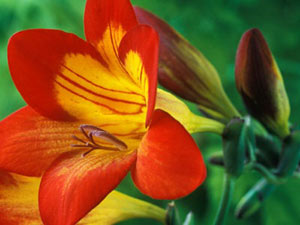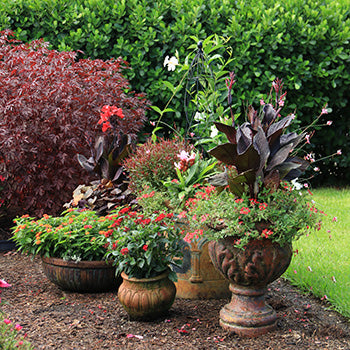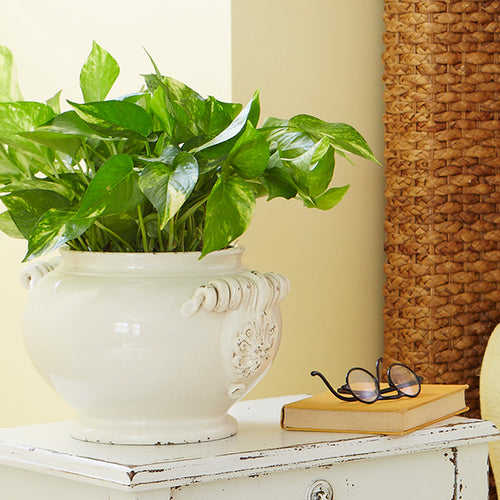By Doug Jimerson

Jumpstart your spring garden by packing pots, planters, and garden beds with cold-hardy Early Blossoms annual flowers. All of them will surprise you with their ability to bloom nonstop in temperatures that would make other annual flowers cringe. Here are eight cold-hardy annuals that you can plant in early spring:

1. Senetti Pericallis
By far, our favorite spring flowers are Senetti . This new line of eye-popping bloomers develops cheerful daisy-like flowers in bright, Easter egg colors that are almost iridescent. Choice varieties include ‘Blue’, ‘Violet’, ‘Magenta’, ‘Blue Bicolor’, ‘Violet Bicolor’, and ‘Magenta Bicolor’. What’s more, they are at their best when temperatures are between 34 and 40 degrees F., which makes them a top pick for late winter and early spring planting. Keep in mind, though, that Senettis are not frost and will need to be brought indoors if freezing temperatures are forecast.
Senettis in the Landscape: Pair with Spring-Flowering Bulbs
Because they bloom so early, Senettis make great partners for spring-flowering bulbs such as tulips and daffodils. As your bulbs poke up through the soil, plant Senettis around them or in pots nearby. Or, team Senettis in large planters with other early bloomers such as cyclamen, and ranunculus. Senettis also look terrific planted en masse along a garden path or packed into a window box or urn. For best flower production, make sure your plants receive as much direct sun as possible.
Caring for Senettis: Keep them for Fall Flowers
Pericallis will stay in almost constant bloom as long as the temperatures remain cool, but to keep them in peak form, trim the stems back by half as the older flowers fade. Then water well and fertilize. In a few weeks, new flowers should start to appear as the plants develop another flush of bloom. Once temperatures climb above 85 degrees the plants will stop blooming. At this time, you can toss them on the compost pile and replace them with summer-flowering annuals such as petunias or geraniums. However, if you want to save your Senettis, move them to an out-of-the-way garden corner and keep watering them through the summer, making sure the soil never completely dries out. As the temperatures cool down in the fall, your plants should come back into bloom.

2. Cyclamen
Another reliable bloomer for early spring display is cyclamen. These cheery little plants grow between 14 and 16 inches tall and produce crown-like blooms in a variety of colors. They also have dark green leaves that are attractively mottled in silver and gray so even when the plant is not in bloom, it remains colorful. They prefer temperatures between 55 and 60 degrees F. and a partially shady location.
Cyclamen in the Landscape: Line a Walkway
For best effect, plant cyclamen in pots by themselves or with other early bloomers. Or use them in garden borders or along a walkway. They require rich, well-drained organic soil and will not thrive in clay or sandy situations.
Caring for Cyclamen: Keep them Moist
Consistent moisture is the key to keeping your cyclamen happy. Water whenever the soil feels slightly dry to the touch. As the older flowers fade, remove them. This will encourage the development of new flowers. Eventually, as the temperatures rise, your cyclamen will stop blooming. You can still enjoy their pretty leaves or toss them on the compost pile and replace them with warm weather annuals.

3. Ranunculus
Instant impact! That’s what you get when you add ranunculus to your early spring garden. Each plant produces wave after wave of petal-packed, crepe-paper-like flowers in a bold array of colors. These flowers grow 12 to 18 inches tall and are so frost tolerant that they can survive occasional temperatures as low as 20 degrees F. They make excellent companions for Senetti and other early-bird species.
Ranunculus in the Landscape: Electric Color for Pots and Planters
Ranunculus are available in a wide variety of electric colors, but orange, purple, rose, scarlet, and yellow are the most common. In areas where winters are cool and mild, they work well planted in drifts or clumps directly in the landscape. However, most gardeners rely on ranunculus to provide much-needed early-spring color in pots, planters, and window boxes. They look good planted by but are at their best mixed with other flowers. Ranunculus also has finely cut foliage that provides interest even when the plant is not in bloom.
Caring for Ranunculus: Set Them in the Sun
Well-drained soil is key to a happy ranunculus. These plants will rot quickly if you keep them in wet, mucky soil. Otherwise, ranunculus no special care and have few pests or diseases. They do require a sunny spot so plant them where they will receive at least 6 hours of direct sun a day. Once the weather warms and the plants stop blooming, pull them and replace with other flowers.

4. Dianthus and Carnation
As fragrant as they are beautiful, dianthus and their cousins, the carnations, are a double treat for your spring garden. Besides a constant supply of flowers, both also offer, pretty gray-green, grass-like foliage that contrasts well with the darker leaves of nearby plants. Dianthus and carnations are excellent companions for Senetti, campanula, freesia, and ranunculus. Choice varieties include ‘Kahori’ dianthus, which has pink flowers and ‘Garden Spice’ carnation, which is available in coral, fuchsia, pink and pink bi-color.
Dianthus and Carnations in the Landscape: Tuck them in Containers
Because both dianthus and carnation are perennial in nature, you can plant them directly in your beds and borders and enjoy them for years to come. However, in the early spring, it’s more effective to mix them in pots and planters with other flowers. If you like you can move them into your garden after the companion plants fade away. ‘Kahori’ dianthus grows only 6 to 8 inches tall so it makes a great edging plant. If you grow it in a container be sure to plant it near the edge, to prevent it from getting smothered by taller flowers in the same pot. It is hardy to zone 3. Carnation ‘Garden Spice’ grows one to two feet tall so works best in the middle of the border or large container. It’s hardy from zones 5-7. Both also attract butterflies.
Caring for Dianthus and Carnation: Low-Maintenance Bloomers
Once planted, dianthus and carnations require almost no care. They like a sunny spot that gets at least 6 hours of sun a day and a rich, well-drained soil that won’t get mucky. After the first flush of blooms fade, shear the plants back by a third of their height to promote the development of new flowers. Both will continue to bloom until temperatures soar. If you keep them watered through the summer they will often pop back into bloom again in the fall. They have few insect or disease problems.

5. Campanula
Campanulas provide a refreshing dose of blue or purple flowers for your early spring garden. Although they only grow 6 to 8 inches tall, they provide tons of color because each plant is literally smothered with large cup-shaped flowers. These hardworking little bloomers make terrific companions for spring-flowering daffodils, as well as Senetti, ranunculus, and dianthus. They are also very attractive to butterflies.
Campanula in the Landscape: Beautiful Blue Hues
Our favorite early blooming are ‘Appeal Deep Blue’, ‘Ocean Blue’, and ‘Royal Blue’. Because they rarely grow over 8 inches tall, they fit easily into a mixed container or hanging basket. In the landscape, use them to edge a garden path or seating area. They also make excellent gift plants and will brighten any sunny indoor location.
Caring for Campanula: Back for Rebloom
Keeping a campanula happy is easy. Just plant it in a sunny spot and water whenever the soil begins to dry. New flowers will continue to appear while the weather remains cool, but once they fade, shear back the stems by a third and you will probably enjoy a new burst of flowers in a few weeks. Campanulas are perennial in nature and will often overwinter in Zones 5-9.

6. Calla Lily (Zantedeschia)
The large, dramatic flowers of calla lily make a stunning focal point in containers, garden beds, or in a vase on your dining room table. These gorgeous South African natives are now available in almost any color other than blue. Depending on the variety, they also have attractively speckled or splotched foliage that looks terrific all season long. Callas can grow up to 24 inches tall so be sure to plant them in the center of your pots or the back of your garden border.
Calla Lily in the Landscape: Plant in Beds or Containers
Some of our favorite varieties of calla lily include: ‘Ice Dancer’, ‘Moon Shadow’, ‘Rubylite Rose’, ‘Sunshine’, and ‘Sweet Talk’. All of them grow equally well in pots or in the landscape. The flowers are long lasting and take a long time to fade, at which point you can clip the old bloom stems to make room for new flowers. Used alone in the garden, calla lilies can look a bit stiff and formal, so for best effect, mix them with other looser plants such as Senetti or campanula that will fill in around the taller calla foliage.
Caring for Calla Lily: Attractive Flowers and Foliage
Calla lilies grow best between 55 and 65 degrees F. They so if cold weather threatens, bring them indoors or move them to a protected spot in your garage or shed. As summer temperatures rise, the plants will stop blooming, but you can still enjoy the plants’ attractive foliage until fall. Calla lilies prefer a sunny to partially sunny spot, and they like their roots to be cool so mulch the soil around your plants to insulate them during hot weather. Feed them with a slow release granular fertilizer sprinkled over the soil surface and water whenever the soil surface feels dry to the touch.

7. Freesia
When planning your early spring pots and planters, don’t overlook freesia. These lovely flowering bulbs produce graceful bloom stalks in an assortment of rich, pastel colors. As a bonus, the flowers are highly fragrant and will perfume your garden with their rich scent. Both single- and double-flowered varieties are available. Freesias also make long-lasting cut flowers for spring bouquets.
Freesia in the Landscape: Graceful Companions for Other Early Bloomers
Although freesias are pretty enough to stand on their own, they are at their best when blended with other spring flowers such as Senetti, ranunculus, and campanula. That’s because freesia has thin, grass-like foliage that almost seems to disappear when you mix it with other plants, creating the illusion that the freesia flowers are floating in . The plants grow about 18 to 24 inches tall and will continue to send up additional flower stalks until the weather heats up. Some of our favorite varieties include: ‘Blue Bayou’, ‘Figaro’, ‘Sandra’, and ‘Texas’.
Caring for Freesia: Cool colors for Cool Temperatures
Although freesia can be started from bulbs or even seeds, the best way to enjoy these bulbs is to buy ready-to-bloom plants. Keeping them happy is not difficult. All they require is a rich, well-drained potting soil and a sunny location that’s protected from warm winds. Freesia like cool temperatures and will fade quickly if temperatures reach the 80s. Water whenever the soil surface feels dry to the touch, but don’t overdo it because these are bulbs and will rot in wet soil. If you want to grow freesia in the garden they are hardy outdoors from zones 8 to 11.

8. Calceolaria: Low-maintenance, Cool-Weather Beauty
Sometimes called pocketbook plant, calceolaria is an amazing annual with cool, orchid-like blooms. The lower petals of the plant have fused together, much like a lady slipper orchid. These blooms are held in clusters on wiry stems above the plant's dark green foliage.
Landscaping with Calceolaria: Enjoy Long-Lasting Flowers
Small (1 foot by 1 foot) calceolaria is ideal for growing in small pots you can use as focal points or accents on tabletops and around decks, patios, and balconies in early spring. Most varieties flower in warm shades of red, orange, and yellow.
Caring for Calceolaria: Bold Blooms for Early Spring
Calceolaria is an easy-care plant that just likes a sunny spot and regular watering. Give it a splash of moisture when the top inch or so of the potting mix dries out. Don't be surprised if calceolaria wilts when it gets too dry. Happily, it rebounds just as quickly as it wilts!
















